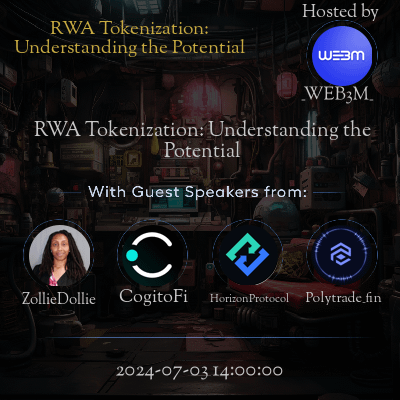Hey, welcome, everyone. Here we are again. I love it. We got another awesome panel. We got some phenomenal people on here today to talk about DeFi. Julian, how are you doing? I’m doing great. Thanks for having me. Yes. Doing well. How are you? Just fantastic. How are you doing? Pretty good. Like Mason said, pretty psyched for the event, so it should be good fun.
Panel Introductions
All right. Well, let’s just kind of start. King, you want to intro yourselves, what you’ve been on in this space? Yes. Absolutely. Thank you, everybody, for tuning in. So my name is King Saucen. I create content all about DeFi. Really, everything DeFi-related to put it. Hey, guys. My name is Julian. I’m very happy to be here today. Thanks, everyone. I’m one of the co-founders of StakerDAO. We’ve been working on the ecosystem for a couple of years now. And yeah, it’s been an interesting journey.
Additional Panel Introductions
All right. Awesome. Now, next up, we got the one and only King Cross Chain. Hello there. Hello. Good to be here. Yes. So I’m King Cross Chain. I build on cross chains. So mainly DeFi. And finally, we got our guest. Thank you very much. And I am Miley. Any guess what I do? Let me think, Miley. Maybe you work with chains? Yes, that’s right. My name is Miley and I love chains. Blockchain, that is. So yes, that’s me.
Evolution of DeFi
All right. So physics for DeFi. I think probably the best first place to start is I guess– so we’re going to get into the meat of the physics stuff later, right? But before we do that, I think it’s probably best to start talking about how DeFi has kind of gotten to where it is today. Yeah. Yeah. Yeah. I think that’s pretty central to everything we’re talking about because, I mean, you’ll look at the world. I don’t look at it much, but yes. It’s a scary place. It is. Certainly, there are challenges ahead. And there have been many since the DeFi space kind of blew up, right?
History of Innovation in DeFi
But I think a lot of what we’re trying to achieve today relates to the challenges we’ve had in the past, right? Yeah. Right. Yes, absolutely. 100%. Yeah. And I think we’ve had a history of innovation and it wasn’t too long ago when we had a lot of really interesting projects launching. But I do think that recently, as the DeFi space becomes more mature, we’ve got to contend with different challenges, different set of problems to solve. No, 100%. I think today we have a lot of infrastructure that we use on a day-to-day basis and that infrastructure seems to mostly be working.
Innovation and Challenges in DeFi
For sure. Yes. But we’re still building on top. We’re still building new things. We’re building new innovations and we’re still pushing forward with new ideas. And I think that’s a key aspect of the space is innovation. I will say this. I was just on a chain yesterday talking to another project, but their focus is DeFi, right? And how they interacted with other protocols. For sure. And ultimately, I think the challenge with DeFi today is like the challenge with the current financial system. We’ve got to figure out ways to make it work for everybody, right? And I think that’s where we are right now.
Importance of Composability in DeFi
Exactly. And that’s why I’m thrilled to have this panel today because we’re going to dive into some of the ways to break through and make it work for everybody at the end of the day. 100%. Yes. I think we can all agree. So going off that, I think it’s exactly right. The challenge, certainly one of the challenges right now is how do you take something as complex as the financial system and make it simple? Yes. I think the idea of composability is very central to DeFi. I mean, it’s huge. Totally agree. Yes. You know, Julian, we were chatting a while ago. I mean, we chat every day, but– All right, all right, all right. Maybe we slow down here. We’ll jump in and we’ll mix it up. So let’s not rush through this.
Defining Composability
Absolutely. We’re going to take our time. We’re going to touch on all these things. So first, let’s talk about what is composability? That’s kind of like the fundamental base of what’s one of the best pieces and what’s the absolute worst pieces. Julian, let’s go. Yes, absolutely. Thank you. So when we talk about composability, what we mean is that there’s this idea that we can essentially make things that are building blocks, right? And together they form one coherent system. And this is extremely powerful when you’re thinking about protocols because if you’re thinking on layer 1 and layer 2 and you’re thinking about programmability, you realize that you need things to be able to interact very well.
Composability in Web2 vs Web3
And I think a lot of that idea has been coming from the Web2 world, right? Yes. Where you had APIs and all these things interacting with each other. Absolutely. So yes. So I think we’re going to get a bit technical here. But we mean, looking at infrastructure as it’s song builds with things interacting together. Andreas, do you have comments? I mean, I think here’s the thing. When we’re looking at composability, it really is taking all these different protocols and making them work together. Totally. I think there’s a beauty in that because once you understand the power of that, right? You realize that you’re not being limited by the technology you’ve built. You can build upon and you can interact with other protocols.
Layer 1 and Layer 2 in DeFi
Yeah. Yeah. Exactly. And I think that’s one of the core pieces that people are missing when it comes to how does this work? They just look at a piece and they don’t realize how much effort goes into making these things work together. Totally. When you say layer 2, some people are even confused as to what it is. So we need get into that next. We’ll do layer 1, layer 2 from King, cross-chain composability, King, do you mind jumping into that? Not at all. So, in essence, composability is quite interesting because it’s almost like you’re building with Lego blocks where you want to take a particular piece. You have a function it does and then you just plug it in into your module and it works seamlessly, right?
Scalability in DeFi
You know, we’re talking about layer 1, layer 2. I think a very interesting aspect here is when you’re looking at stuff that Ethereum is doing. Yes? The ecosystem they have around, there’s a lot of layer 2 solutions, the Ethereum virtual machine. And right now, different chains are trying to build around the ethereum ecosystem to make it more scalable and usable. Fascinating. All right. Well, let’s move forward again and see where we dive into next. So, Andreas, I think King just mentioned scalability, right? Let’s talk about scale. I mean, you look at the current financial system. You look at what we have. Yeah. So scalability is essentially when you’re trying to look at the total throughput of transactions you can make and who can access them.
Importance of Scalability
And right now the challenge is most projects are starting realize they need scale and users need scale because essentially they’re saying, hey, listen, you know, if I can’t process all these transactions on chain, I’m going be stuck with a bottleneck, right? And if you’ve got a bottleneck, then you can’t have global liquidity, which is important to Defi. So I think a lot of key challenge is looking at how do you increase scale while maintaining decentralization and that’s where things like layer 2 come in, right? You look at how do you build upon the underlying layer 1 technology to create something that’s scalable, usable, but also secure. I think you touched on an interesting point here and we definitely should talk about, EVM, the ethereum virtual machine, but let’s also talk about what’s happening in the other chains.
Innovation in Other Chains
Absolutely. So what’s some of your thoughts on how different chains are building to be more scalable? Right. Like Binance Smart Chain, for example. How is that tackling things? Yeah, that’s really interesting because a lot of them have been focused on improving their infrastructure. I mean, they’re taking existing models from ethereum and improving upon them. Absolutely. Like, for example, when you look at Avalanche, it’s doing so well in creating its own unique solution to blockchain trilemma. Yes, and there’s a lot of innovation going on in different spaces trying to essentially build a better mousetrap.
Interoperability in DeFi
Yeah. Let’s touch on a final thing that I think is quite crucial and it’s been a buzzword you’ve been hearing lately and that’s interoperability, right? So, interoperability is how different blockchains work together. Now, let’s dive into that. You know, Miley, can I get your thoughts? Oh, totally. So, interoperability, I really like this topic because it essentially means that you don’t want closed door gardens. Imagine you had an apple garden and a pear garden and they weren’t allowed interact. That’s not interesting, right? You want them to work together. It gives you more options and it increases the overall value for the user. Now, different chains are trying to achieve this by creating these bridges which connect different blockchains together.
Role of Oracles in Interoperability
So you have one protocol that’s on Ethereum and you want to interact with something on Polkadot. And there’s efforts going on to essentially connect these different chains which increases liquidity and also functionality. That’s why I think interoperability is central to scalability. Yeah. So, an example on how they’re doing that is essentially using an oracle, right? The idea behind oracles is to create a secure and reliable means of communication between different blockchains and real-world data in essence. Yes. Absolutely. Like Chainlink, for example? Exactly. Chainlink is a perfect example of someone doing really well. That’s a very good example. There’s a lot of projects looking into how they can implement that sort of structure and make it work for everybody essentially.
Simplifying DeFi for Users
Right. Well, I mean I love this. We’re getting so much information but I want to pull it back a bit. Julian? Do you think we’re complicating things too much right now? I mean, people come to me all the time and say, you know, I don’t understand Defi, it’s too complicated. How do we break it down? Absolutely. Thank you for pulling that back. So I think for most users the idea behind Defi is trying to create an open financial system that doesn’t rely on the centralized kind of traditional banking system, right? So we’re using blockchain technology, creating protocols that allow individuals to essentially be their own bank which means you can have complete control over your assets at any time.
Security Concerns in DeFi
You’re essentially opting out from the middleman and that brings us what the composability piece, right? Because you have these different protocols working together, interacting, which allows you to take control of your assets more effectively. I think that aspects of decentralization, though quite powerful can be overwhelming. For instance, when you’re talking about security, that’s like a big concern right now. Oh, absolutely. You look at some of the news lately with some of the hacks. Yes. Absolutely. For sure. People bring up security all the time. I think at the end of the day what we’re all trying to do here, and this is also very central to Defi, is figuring out a way to make things as secure as possible for our users. 100%.
DeFi’s Unique Value Proposition
All right everybody, we’re going to move on to the next segment of our panel, which is essentially going to be touching more on the fact that Defi isn’t just a derivative of traditional finance. It’s creating its own value proposition that is almost completely separate. Yeah. Cool. Absolutely. We’re witnessing the creation of a completely new system that I think people don’t fully understand yet, right? It’s new, it’s innovative, and we’re figuring it out as we go. Totally. So, everyone, get comfortable, get a cup of tea or whatever your beverage of choice. We’re going to dive deeper. Julian, take it away.
Power Shift in DeFi
Yes. So in essence, what I think is completely unique about Defi, is that we’re seeing a move away from centralized systems where essentially a few people have all the control towards a more distributed and decentralized way of the financial ecosystem. That means we’re creating something new. We’re giving power back to the people. So the power dynamics are shifting. That’s huge. Right. That’s quantum. Quantum, for sure. And I feel this aligns perfectly with what we’ve been building at StakerDAO, where essentially users decide the future of the protocol through a decentralized autonomous organization which is like a new type of democratic financial model. Totally. A total game changer.
Game Theory in DeFi
Now guys, speaking of game changers, Miley, can you talk about how game theory plays into this new decentralized world? Oh, I’d be happy to. So in essence, game theory in the sense of Defi is trying to figure out how different stakeholders in the system can incentivize each other to work towards common goals. You want everyone aligning towards the same directions of prosperity. Sure. That’s essentially what we’re talking about when we discuss protocol design or tokenomics, how do you create a system that incentivizes good behavior and essentially punishes bad behavior to create the best possible ecosystem.
Staking and Yield Farming
Exactly. And I think one of the grounds where this is applied is essentially looking at staking and yield farming. Exactly. Looking at dynamic strategies where everybody gains, essentially because when you’re designing these systems, you’re trying to create something that allows for win-win situations for all parties involved. Yes. Absolutely. 100%. For sure. This idea is not new, right? It’s based on economics and finance theories that go back decades, but it’s being applied in a whole new way in the space. Totally.
Cognitive Shift in DeFi
Well, listening to everyone, I think it’s clear that the shift happening in Defi is not just technical but cognitive as well. It’s changing the way we think about finance fundamentally. Julian is right. There’s a complete mind shift happening. Listen, we’ve been doing finance one way for hundreds of years and suddenly everything’s changed. So naturally, people are taking time to adapt. Totally agree.
Future Trends in DeFi
All right. So looking ahead, what are some trends everyone here thinks we’ll be seeing in the Defi space going forward? I think one trend that’s really going to be big is integration with taxation systems. As Defi becomes more prevalent, the traditional financial system and regulatory bodies are going to need to figure out how to deal with it. Sure. Yeah. For sure. And another trend we might see is the continuous push for cross-chain interoperability as projects look to expand their ecosystems and liquidity. Absolutely. Yes. But what about user experience? That’s a tough one, don’t you guys think? Oh, definitely. Absolutely. I mean, given that right now, user experience isn’t exactly the easiest for just average individuals. It’s going to be very important to make it user-friendly. Yes. Yeah. 100%. Absolutely.
Closing Remarks
Okay. Ladies and gentlemen, we’re just about to wrap up here. I want to thank each and every one of you for being here. Your insights have been priceless. Thanks so much. Thank you for having us. This was a lot of fun. I’m looking forward to the next one. Absolutely. Thanks everyone for tuning in. Make sure to catch up on previous spaces. Bye. Goodbye. Bye all.







